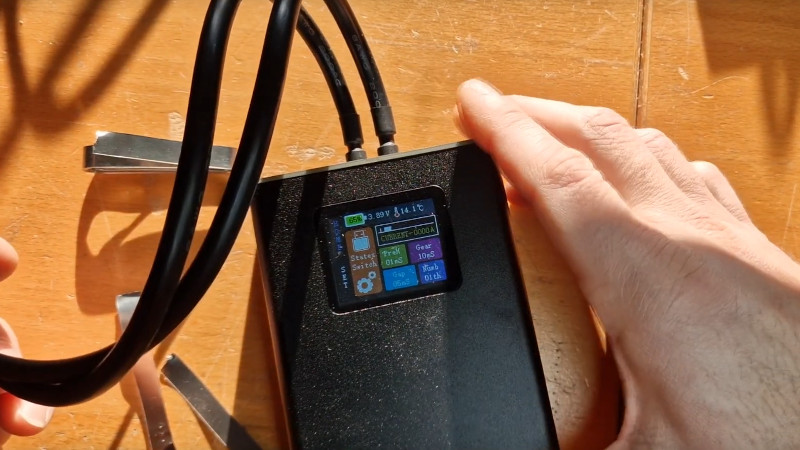There was a time when every gizmo on AliExpress also had a big white LED so it could also work as a flashlight, but maybe the power bank is the new flashlight. [Aaron Christophel] has a battery spot welder that costs a not unreasonable 30 euros and can also be used as a novelty power bank. He subjects it to a test and teardown in the video below the break.
First of all, he conducts a few weld tests, and we have to say it seems capable of some reasonable results if its parameters are correctly adjusted. Then the end comes off the extruded aluminium case, and the guts of the device are slid out for a teardown.
The power comes from a pair of Li-Po pouch cells, while on the board, there’s an STM32 clone providing the timing for a set of MOSFETs that do the heavy lifting. There’s a colour display for tweaking the settings. Alongside all this, there’s also a small chip for that power bank functionality. Charging is via USB-C, though, of course, it’s not really proper USB-C but a USB-C socket that expects 5 volts. This is a disappointing trend in cheap electronics that sullys the promise of USB-C.
It seems this spot welder is capable of doing the job, which is pleasing after our previous disappointing look at battery welders.
















In my experience these work quite well for the nickel plated steel strips.
They do not make good welds in the lower resistance pure nickel strips.
Perfectly usable for rebuilding a basic power tool battery, but not adequate for high power electric scooter batteries.
Exactly. The specs for these devices will say, e.g., welds 0.15mm nickel! They almost always mean nickel plated steel. But some of the (more expensive) supercap units can do better and are still a good deal for hobbyists.
Any particular model suggestion? I’ve been just about getting to doing the research for a spot welder as I’ll need one for some upcoming ideas and I’ve a battery tool or two that could do with a repair. Be nice to have some suggestions on which devices are worth it.
If you want to DIY, there was a good design published in Silicon Chip in their March 2022 issue. Depending on how many capacitor banks you build and where you source the caps, you’re looking a couple of hundred dollars. Not cheap, but as you may have guessed, it’s also easy to customise for your own needs, and very well documented. Link to part one here: https://www.siliconchip.com.au/Issue/2022/March/Capacitor+Discharge+Welder%2C+part+one
Nice to have have something very portable and compact for in the field!
However in general everything you change physically influences the necessary settings. Getting good repeatable results means controlling the physical environment which is not easy in the field. The energy injected in the weld spot will be heavily dependent of the battery health. For general usage I would like a more intelligent welder, for example the one found at https://www.keenlab.de Not as cheap and sexy but a tighter control over the amount of energy that will be injected in the weld spot. Be careful soldering Lithium batteries, especially the Li-SOCL2 ones can be very unforgiving with life altering consequences if you inhale their toxic magic smoke.
Learned lesson: I bought that same crap, used it to repack a battery set for a EV cart, the welds don´t hold much. Several detached after a while
That was not well spend money.
It´s neither a satisfying spot welder, maybe a just decent power bank.
Steer away from that kind of crap !
Is this useful for anything besides welding contacts to batteries?
I spose you could weld any similar thickness of any sheet metal. Probably even more effective on steel since higher resistance makes more heat faster. However often one needs to spot weld where there is no ac power available seems like an edge case to me. Like where are you going to receive these batteries where there is no ac available? Are Mouser and Digikey now delivering to deserted islands somewhere? Also seems more risky since slower heating would increase the heating of the cell itself.
“After all, why not? Why shouldn’t I add a white LED and a USB port?” -Bilbo Baggins
Yeah I hooked up a moped that said it would do 25 mph to my 6000 lb travel trailer and it wouldn’t even do 1 mph ! I bet this power bank wouldn’t help it go either. :-) That’s a smiley face, by the way.
I’m pretty sure a USB-C port that expects 5V is still a “proper” USB-C port; it just doesn’t support USB-PD. This is very intentional — manufacturers need only to slap a USB-C port and the proper resistors onto their existing design, and you already get the benefit of being able to use your universal cable.
If plain 5V charging weren’t considered “proper” USB-C, we’d be forever stuck in a hell where cheaper devices still used Micro USB and you’d need a million cables.
That’s the problem, most don’t slap the resistors on, so only work with an A-C cable.
As my buddy Rory used to say, every Craftsmen tool ever made is also a hammer; a chisel, and a pry bar…